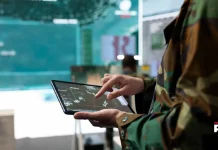What is a Smart Lighting System?
Smart lighting is an innovative way to illuminate your home. Smart LED bulbs include software that connects to an app, smart home assistant, or other smart accessory, allowing you to remotely automate or control your lights, eliminating the need for traditional wall switches.
Intelligent lighting is becoming more popular. Create a range of preset lighting moods for a variety of activities, from weeknight cooking to weekend movie marathons. Setting a ‘rise and shine’ timer allows us to gently wake up to softly brightening light. The dimming kit white spectrum transforms the room and atmosphere from reading light to dancing light and back again with a single click of the remote control.

Building energy efficiency has sparked widespread interest, as the construction industry is the most energy-intensive, accounting for more than half of global electricity consumption and more than one-third of total energy consumption. The International Energy Agency predicts that if certain measures to improve building energy efficiency are not implemented, building energy demand will increase by 50% by 2050.
Smart technology advancements have ushered in a new generation of building energy behaviors and control approaches, where smart lighting systems have a direct impact on energy savings, user comfort, health, and safety. Unlike traditional lighting systems that rely on manual on/off switching, smart lighting systems use advances in light-emitting diodes (LEDs) and information and communications technologies (ICTs) such as wireless networks and sensors to create efficient and healthy lighting.
Connectivity
Smart lighting uses an information carrier, such as the Internet or something similar, to make lighting nodes individually addressable and digitally controllable. To communicate between the lighting nodes and the information carrier, network connectivity is required. It is commonly assumed to be made up of wireless devices.
The communication technologies listed below are used to remotely control lighting systems by connecting them to the internet or a smartphone.
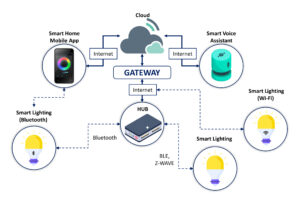
- Wi-Fi Connected System ~ Smart lights based on Wi-Fi are network-connected and can be controlled remotely via Wi-Fi routers. They cannot, however, be controlled unless an internet connection is available.
- Bluetooth Connected Smart Lights ~ Bluetooth-enabled smart lights can form a mesh network and be controlled by BLE-enabled smartphones. To control Bluetooth-enabled smart lights remotely, a Bluetooth Hub is required. A Bluetooth hub is a piece of hardware that connects Bluetooth-enabled devices to the internet.
- ZigBee / Z-Wave Connected System ~ Smart lights based on ZigBee and Z-wave, like Bluetooth-based lights, form a mesh network. They cannot, however, be controlled in the absence of Hub. To control them, a ZigBee / Z-Wave Hub is required.
Depending on the wireless technologies used in the light bulb or light switch, some will require a hub or a gateway to connect the bulb or switch to a home Wi-Fi network, allowing the fixtures to be controlled remotely via Cloud applications. Vendors in this space are attempting to make their hubs as open as possible in the hopes of gaining a foothold for other smart home applications in the future. Interoperability exists between products from Wink, Phillips, and others. Without a home network connection, the fixtures can be controlled directly via Bluetooth from a smartphone or tablet, but only with a physical presence.
Architecture for Smart Lighting Systems
Widespread computing, as well as recent advancements in the miniaturization of electronic components for the smartphone industry, have enabled you to connect any device to your smartphone and a cloud to integrate it with a plethora of online services. Let us now look at how these technologies transform our energy-saving light bulbs into the marvels of smart bulbs.
Smartphone Centric Architecture
A light bulb is connected directly to a smartphone via Bluetooth in smartphone-centric architecture. As a result, the light bulb does not have a direct Internet connection and is dependent on the smartphone’s proximity.
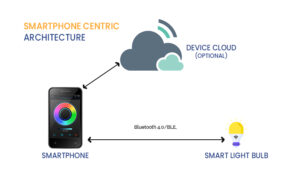
In this case, the light bulb can only be connected to the Internet via the smartphone. As a result, any smart feature that relies on the Internet is only available near the smartphone. It’s the same as triggering an IFTTT action only when the smartphone is within Bluetooth range (up to 100 meters), because there is no connection between IFTTT and the light bulb without the smartphone.
Customers benefit from this architecture because they do not need an additional device or hub to connect the light bulb and can control it from their smartphone. Furthermore, the user interface is simple and straightforward, but it comes at the expense of relying on a smartphone to connect to the Internet.
Hub-centric Architecture
Since it usually connects to the home Wi-Fi or Ethernet network, the Hub in hub-centric architecture acts as an intermediary for connecting a bulb to the smartphone and the Internet. A smart light bulb is completely independent of a smartphone and may be intelligent on its own.
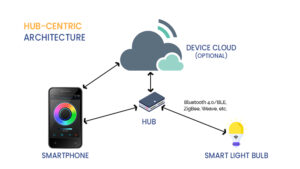
The hub-centric architecture makes it easier to organize and connect the many light bulbs and other appliances in a house. Every connected device can be controlled at any time and from any location. Background smart triggers from third-party services (IFTTT, stock market dynamics, and so on) are easily achievable, as is controlling lights from any smartphone owned by the homeowners.
A device cloud is optional in this architecture because many smart features can be set up without a dedicated cloud infrastructure. However, with the cloud, features become more robust and reliable because there is significantly more computational power available in the cloud for complex tasks than on a hub device alone.
Cloud Centric Architecture
Without a hub, we have a smart device that is directly connected to the home Wi-Fi network and does not require any additional hub to function. It has a simple setup process for the customer and looks similar to the Smartphone Centric Architecture, but with the added benefit of a direct and constant Internet connection of the device.
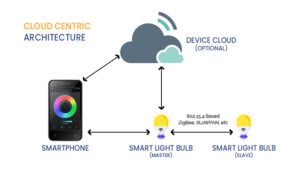
This architecture can sometimes resemble the Hub centric architecture in that a Master-Slave relationship is organized with similar smart devices. The Wi-Fi network connects the master device to the internet, and the mesh network connects other devices to the master and to one another (802.15.4, 6LoWPAN, etc).
The advantage of this architecture is that there is no need to purchase and install additional devices while maintaining a constant and independent Internet connection.
Smart Bulb Components
Smart Bulbs typically have few components that are indispensable for any smart lighting system.
Power management
![]() Step down from 120/240V to 12, 6 or 3 volts to power LEDs, sensors, and other output devices like speakers. This power supply powers a DC-to-DC converter as well as the LEDs. A large 10uF input capacitor, an STMicroelectronic VIPer22A-E (PDF) switcher, a transformer, and output smoothing capacitors comprise this AC-to-DC power supply.
Step down from 120/240V to 12, 6 or 3 volts to power LEDs, sensors, and other output devices like speakers. This power supply powers a DC-to-DC converter as well as the LEDs. A large 10uF input capacitor, an STMicroelectronic VIPer22A-E (PDF) switcher, a transformer, and output smoothing capacitors comprise this AC-to-DC power supply.
LED
![]() LEDs are a type of SSL (solid-state lighting). That is, instead of heating a tungsten filament in a vacuum or applying a current to a gas and then converting that energy to light, solid-state lighting simply applies electricity to a material. As a result, there are fewer steps between the electricity and the produced light, giving you LED owners more efficiency.
LEDs are a type of SSL (solid-state lighting). That is, instead of heating a tungsten filament in a vacuum or applying a current to a gas and then converting that energy to light, solid-state lighting simply applies electricity to a material. As a result, there are fewer steps between the electricity and the produced light, giving you LED owners more efficiency.
Microprocessor
![]() An LED light’s shell is typically divided into three sections: the primary circuit board, a large heatsink, and the base with the power supply. Running a stripped-down Linux or other RTOS with security components, drivers, and agents to collect data from sensors and wirelessly send it to a smartphone, hub, or the cloud.
An LED light’s shell is typically divided into three sections: the primary circuit board, a large heatsink, and the base with the power supply. Running a stripped-down Linux or other RTOS with security components, drivers, and agents to collect data from sensors and wirelessly send it to a smartphone, hub, or the cloud.
Wireless radio(s)
![]() In some cases, one or more of the following Wi-Fi, BLE, ZigBee, and other technologies are used. As chip functions consolidate, support for multiple radios is becoming more common.
In some cases, one or more of the following Wi-Fi, BLE, ZigBee, and other technologies are used. As chip functions consolidate, support for multiple radios is becoming more common.
Environment Sensors
Motion, temperature, humidity, ambient light, and sound detection could all be included. Intruders could be detected using motion and sound in home security applications, while temperature and humidity sensors could be used as inputs to a Smart HVAC system.
Smart bulbs are embedded with certain sensors that create an intelligent control system.
1. Photosensitive Sensor
![]() The photosensitive sensor is an ideal electronic sensor that can control the circuit to switch on and off automatically in response to changes in illuminance in the morning and night (sunrise and sunset). The photosensitive sensor can automatically control the on/off of LED lighting based on the weather, time period, and region.
The photosensitive sensor is an ideal electronic sensor that can control the circuit to switch on and off automatically in response to changes in illuminance in the morning and night (sunrise and sunset). The photosensitive sensor can automatically control the on/off of LED lighting based on the weather, time period, and region.
2. Infrared Sensor
![]() Infrared sensors detect infrared rays emitted by human bodies. The basic idea is that the infrared ray emitted by the human body is about 10 m long, which is then magnified by a Fresnel filter lens and focused on a pyroelectric element PIR (passive infrared) detector.
Infrared sensors detect infrared rays emitted by human bodies. The basic idea is that the infrared ray emitted by the human body is about 10 m long, which is then magnified by a Fresnel filter lens and focused on a pyroelectric element PIR (passive infrared) detector.
3. Ultrasonic Sensor
![]() In recent years, ultrasonic sensors, like infrared sensors, have found more applications in the automatic detection of moving objects. The Doppler Principle is primarily used by the ultrasonic sensor to emit a high-frequency ultrasonic wave through the crystal oscillator that is greater than the human body can perceive.
In recent years, ultrasonic sensors, like infrared sensors, have found more applications in the automatic detection of moving objects. The Doppler Principle is primarily used by the ultrasonic sensor to emit a high-frequency ultrasonic wave through the crystal oscillator that is greater than the human body can perceive.
4. Voice Sensor
![]() A sound control sensor, an audio amplifier, a channel selection circuit, a delay-on circuit, and a thyristor control circuit comprise the voice sensor. In general, the sound comparison result is used to determine whether the control circuit should be started. The regulator also provides the original value setting of the voice sensor.
A sound control sensor, an audio amplifier, a channel selection circuit, a delay-on circuit, and a thyristor control circuit comprise the voice sensor. In general, the sound comparison result is used to determine whether the control circuit should be started. The regulator also provides the original value setting of the voice sensor.
Smart Lighting System Deployment
The placement of the Smart Lighting System is extremely important. The components differ accordingly, resulting in a well-built system for environmental sustainability.
Indoor Deployments
LED lighting powered by PoE is now commonplace and an obvious choice for deployment indoors in new commercial developments or major building retrofits. Other low-power building automation solutions (Security systems, Surveillance, HVAC, etc.) have already followed this PoE path due to the LAN / WLAN infrastructure expected to be present in any modern facility.

Many vendors in this space are evolving their cloud or premises-based control systems to be more like IoT platforms, with APIs that allow other vendors’ building automation devices to be unified, or that allow partners and users to build custom applications on top of their management framework.
The combination of sensors and smart lighting is not the only trend we are seeing. There are also new applications combining smart lighting and wireless communications, such as incorporating a Wi-Fi Access Point or Bluetooth beacon in retail lighting fixtures to provide shopper assistance and push marketing, location tracking, and customer analytics.
Outdoor Deployments
Over-lighting unused streets and public buildings costs cities a fortune. They require a diverse range of solutions, and due to the distances involved, the majority of them will employ one of several narrow-band wireless technologies that offer greater range than Wi-Fi or Bluetooth.

Meanwhile, carriers are constantly pressuring municipalities to expand mobile broadband infrastructure for new cell towers and micro-cell sites. Ericsson and Phillips have devised a method to densify mobile networks without clogging the city. This Zero Site solution employs a multiservice smart lamp pole designed to house small cells, Wi-Fi hotspots, and other network equipment, with the space available for rent to MNOs.
Municipalities and utilities will use a mix of solutions to address various communications and lighting requirements. Georgia Power, for example, which has installed 500,000 LED fixtures in the last four years, employs a mix of star- and mesh-topology wireless networks that support various standards.
Conclusively..
Smart lighting has a promising future, with applications in both residential and commercial settings. You can reduce customer energy consumption while also improving your family’s health and wellness by utilizing smart lighting networks. Also, keeping up with the developments in the market, this industry is bound to have galloping developments in the next few years. In this generation of connected devices, the pertinence to have a connected bulb is evident.
Read More: Smart Lighting Craze – All About Networking, Communication, & Architecture Of Smart Bulbs

